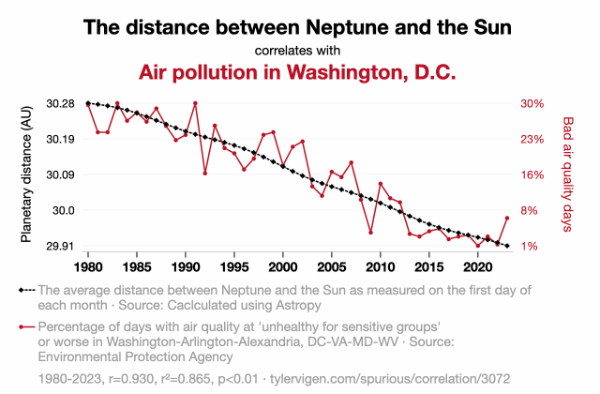Linear regression/correlation coefficient (AA/AI SL 4.4, )

| Factual Questions: | Conceptual Questions: | Debatable Questions: |
| What is the correlation coefficient calculated from the given data? | What does the correlation coefficient indicate about the relationship between two variables? | To what extent should statistical tools like correlation coefficients influence decision-making? |
| How is the slope of the regression line determined? | How does the regression line relate to the concept of covariance between two variables? | Should outliers always be removed from data sets in regression analysis? |
| What are the calculated slope (b) and y-intercept (a) of the regression line? | In what situations might a high correlation coefficient be misleading? | How might the perceived objectivity of statistical analysis be compromised by the way data is presented or manipulated? |
| How does moving a data point affect the slope and y-intercept of the regression line? | What are the limitations of using linear regression for predictive modeling? | How can data analysts ensure that their interpretation of regression and correlation is ethical and unbiased? |
Scenario: The Statisticians' Detective Agency
Background:
The Statisticians' Detective Agency specializes in uncovering hidden relationships within data. Their latest tool is the "Linear Regression and Correlation Coefficient" applet, which helps visualize and calculate the relationship between two variables.
Objective:
As a detective at the agency, you are tasked with using the applet to investigate the strength and nature of the relationship between two suspicious variables in a recent case of data anomaly.
Investigation Steps:
1. Examining the Evidence:
- Plot the data points provided by the case files onto the applet.
- Observe the scatter of the points and hypothesize about the possible relationship between the variables.
2. Calculating the Correlation:
- Use the applet to show the calculation of the covariance and the variance of x and y.
- Determine the correlation coefficient to quantify the strength of the relationship.
3. Revealing the Regression Line:
- Display the regression line on the graph, which represents the best fit for the data.
- Calculate the slope (b) and the y-intercept (a) of the regression line using the applet.
4. Interpreting the Results:
- Analyze the equation of the regression line to understand how one variable predicts the other.
- Use the correlation coefficient to discuss the reliability of this prediction.
Questions for Investigation:
1. Discovery Question:
- How does the correlation coefficient reflect the accuracy of the regression line as a predictive model?
2. Manipulating Data Points:
- What happens to the correlation coefficient and the regression line if you move the data points in the applet?
3. The Role of Outliers:
- How do outliers affect the regression analysis and the correlation coefficient?
4. Reflection:
- Reflect on the importance of linear regression in data analysis across different fields.
Fun Elements:
- Host a "Correlation Quest" where detectives use the applet to solve a series of data-related mysteries.
- Create a "Regression Race" competition where participants adjust data points to achieve the highest correlation coefficient.
Through this mini-investigation, you will not only solve the case of the anomalous data but also delve into the exciting world of statistical analysis.
Part 2 - Tesitng your understanding
Linear regression and correlation exam style questions
![[MAA 4.4] LINEAR REGRESSION.pdf](https://beta.geogebra.org/resource/datywxt7/YZvmvXArux9eXzEG/material-datywxt7-thumb.png)
![[MAA 4.4] LINEAR REGRESSION_solutions.pdf](https://beta.geogebra.org/resource/zqgd5wd7/gFFclNdZD5PqNOjN/material-zqgd5wd7-thumb.png)
